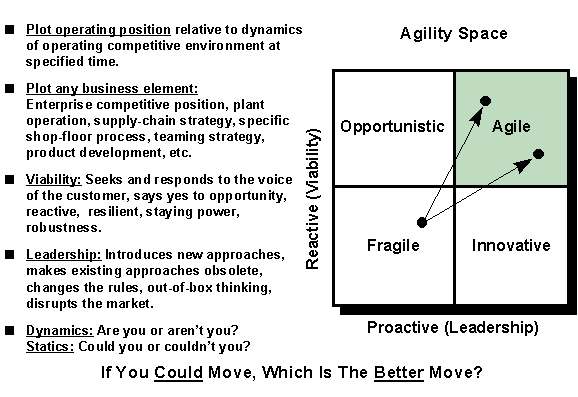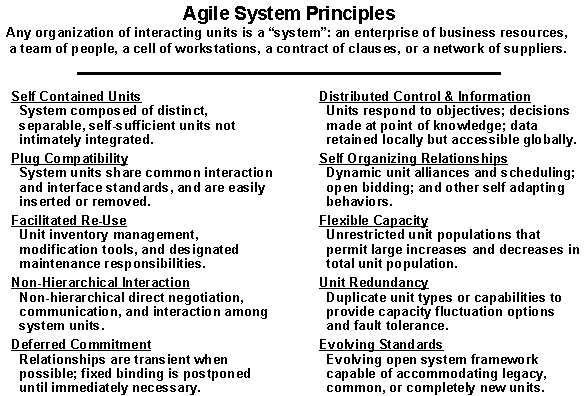Rick Dove, Paradigm Shift
International, www.parshift.com, ![]()
How much of each is needed at any time is a relative question - relative to the dynamics of the competitive operating environment. Though it is only necessary to be as Agile as the competition, it can be extremely advantageous to be more Agile.
All of this talk about "how Agile" and "more Agile" implies we can quantify the concept, and compare similar elements for their degrees of Agility. However, as the associated figure shows, there is some question about value tradeoffs between an increment of leadership and an increment of viability.
Leadership wins if the leader always chooses the most optimal path to advance - but one false step allows a competitor to seize the advantage; putting the previous leader in reaction mode. A competitor with excellent viability can track the leader, waiting for that sure-to-come mistake. Poor viability may then keep the fallen-from-grace ex-leader spending scarce resources on catch-up thereafter.
Choosing a desired spot in the Agile quadrant is one of the important ways to strategically differentiate yourself from your competitors. Getting to your chosen spot is another issue entirely - and a job for masters at business engineering, not business administration.
How innovative/opportunistic are you - relative to your competitive needs and environmental situation? How fast are the rules changing in your market? Are you able to respond fast enough, can you introduce a few changes of your own? Importantly - what allows you to do that? We will look shortly at some promising design principles to answer this last question.
The search for metrics and analytical techniques that can pinpoint an enterprise in the Agility space is receiving a lot of attention today. Self analysis tests that ask lists of questions are one form, house-of-quality QFD-like templates are another. These have a certain appeal in that they deal with familiar concepts that enjoy intuitive association with Agility: teaming, empowerment, partnering, short-cycles, integrated process and product development, and so forth.
But experience shows us that simply saying yes to these questions will not tell us anything useful - too many people, for instance, will say yes to having empowered teams when the yes-ness has nothing to do with the quality of the implementation, or if the implementation promotes Agility.
Better to ask how well we respond to critical types of unexpected situations, how often we lead with a meaningful innovation, how proficient we are at a variety of identified change we feel to be strategically important. For sure, empowered teams embody an organizational structure and business practice that can help us be more Agile if they are designed and supported with that end in mind.
Firstly, we must locate ourselves (qualitatively) in the Agile space relative to our environmental and competitive realities - a subject of some depth that will be covered at another time. Then, where we find ourselves wanting, we must select and design appropriate strategies to move us to where we want to be. The selection of appropriate strategies will change with the times, and differ from market to market; and today might include concepts like mass customization, virtual
Strategic concepts by themselves are open to a wide range of interpretation, and are often interpreted incorrectly. Commonization in shop-floor controls, for instance, doesn’t pay Agility dividends if it is interpreted as buying controls from one vendor; empowerment doesn’t pay without an information and support infrastructure; and customer listening doesn’t pay when competitors change the rules.
Regardless of the strategies chosen, effective implementation will employ a common set of fundamental design principles that promote proficiency at change. .
Getting to your chosen spot and staying there is a job for masters at business engineering, not business administration.
Designing Agile systems,
whether they be entire enterprises or any of their
critical elements like business practices, operating
procedures, supply-chain strategies, and production
processes, means designing a sustainable proficiency at
change into the very nature of the system. With the
business engineer's eye we will be interested in both the
statics and the dynamics of these systems - where the
static part is the fundamental system architecture and
the dynamic part is the day-to-day reengineering that
reconfigures these systems as needed.
Seeking and sustaining a desired
opportunistic/innovative profile will rely upon the
Agility of these systems, which in turn will be impeded
or enabled by their underlying architectures. Earlier
essays have discussed Reusable/Reconfigurable/Scalable
(RRS) system strategies that employ a Framework/Module
approach. The accompanying table completes the
engineering strategy by advancing a set of design
principles for these RRS systems. These principles have
emerged from observations of both natural and man-made
systems that exhibit RRS characteristics, with
contributions from the Forum's Agile Practice Reference
Base, Kevin Kelly's thought-provoking book (reference
below), and the sizable body of knowledge growing out of
object oriented systems design.
We will explore the application of
these early stage principles in the next issue, tying
them into various business strategies critical for the
Agile enterprise.
Business strategists recognize the
imperative of the Agile enterprise, with virtually all
popular business writers today extolling the need for
change proficiency of one kind or another: Peter Drucker,
Tom Peters, Michael Hammer, Peter Senge, and all the rest
are talking about today’s dominant effects of a
faster paced business environment. The newly released Agile
Competitors and Virtual Corporations by Goldman,
Nagel, and Preiss provides an encompassing view for most
of these concepts with many examples. Richard
D’Aveni’s excellent Hypercompetition
focuses on wielding change proficiency as a preemptive
business strategy. And Kevin Kelly’s Out of
Control provides fundamental examples for the
business engineer who would design and build Agile
enterprises and systems.

